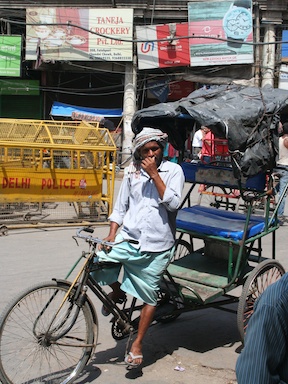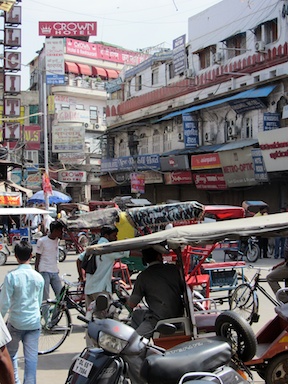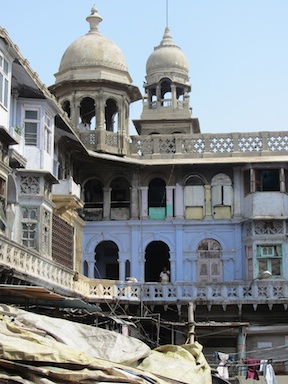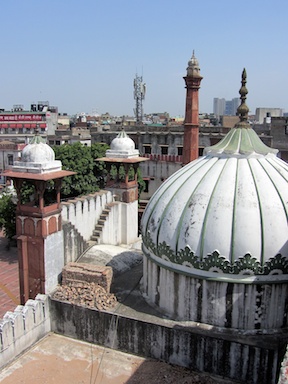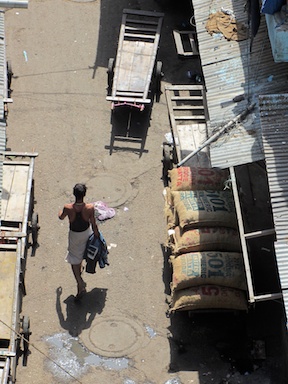What can I say about driving in old Delhi? There are cars and trucks and rickshaws everywhere, all mixed up with pedestrians and bicycles and porters. There are no valid road markings and few signs. Horns sound continuously, but not in anger, just to alert other drivers that you are inches behind them, because nobody uses mirrors.
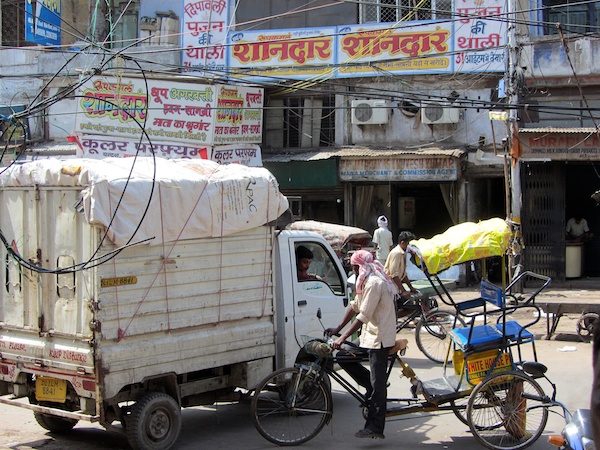
Bronwyn and I had just emerged from Red Fort with our friends Ankur and Shalu, who had engaged a couple of rickshaws to take us all on a sight-seeing tour of the old town. Our driver was brilliant, pedalling us up and down the tiniest of soukh alleyways, panting and puffing under what I imagined to be the unexpected weight of two tall westerners. However, while waiting at the top of a particularly steep hill, our driver laughed good-naturedly at his colleague labouring along behind us, because neither Ankhur nor Shalu are particularly tiny either.

We visited a thousand-year old temple with hundred-year old mosaics, belonging to a strict Hindu sect that didn’t allow any leather inside. Shalu volunteered to stay outside with our shoes, belts and bags while an elderly toothless monk showed us around. We couldn’t take any photos inside either, but it was an old space filled with kitchen cupboards and old chairs, with occasional rather spectacular mosaics and sculptures. Overall it was a very nice little temple.
We had a good time at the spice soukh, chatting to the merchants who were more than happy to allow us to taste their wares and let us take photos of their produce. We stocked up on chai tea and some really good quality spices.

Our rickshaw drivers then took us up some rickety stairs above the market, past tatty-looking legal offices and stepping over sleeping people (there are sleeping people everywhere) to the rooftops where we had an unrivaled view of the old city. Locals were having a good laugh flying kites from the roof, it was a relatively cool and breezy place to hang out.
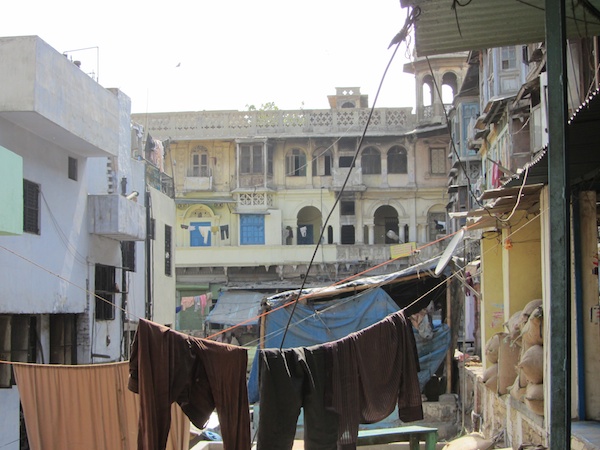
We were starting to feel more than a little hungry, so Ankur asked the drivers to drop us at Karim’s, a famous restaurant catering for “non-vegetarians”. Karim’s consists of an open-air triangle bounded by tiny cafes on each side. We were led up a wooden staircase to a balcony above the kitchen, where we were served some of the best Indian food that I have ever tasted. Mutton Queerma (Korma), an incomparable Butter Paneer, and an awesome and apparently nameless rice dish.
As evening drew in, Tanu arrived in her car with six-month-old Amaira, and drove us out to New Delhi to see the nightly water show at the temple of Akshardham. It took us some time to make sense of the mass of milling and excited bodies by the ticket office, being herded here and there by whistling and shouting security guards, before we realised that we didn’t need a ticket at all if we didn’t want to visit the temple building, which anyway was just closing. There was however an enormous list of banned articles, including cameras and phones, food and drink, any kind of bag, and some odd things such as USB drives and, amusingly, ‘drunkards’.
This meant in turn that there was another immense jostling crowd for the cloakroom, with lots of pushing and shoving and shouting as people tried to store their bags. Instead we dropped all our prohibited items back at the car and joined the queue for the queue for the security check. There was still lots of pushing and shouting and attempts at queue-jumping, but in an amiable kind of way with lots of laughter. Every ten to fifteen minutes, the security guards at the head of the queue lifted a rope and everybody surged forward, sprinting to join the back of the next queue.
Here people were separated by whistling guards into separate lines, who maintained order by solidly body-checking anybody who tried to change queues. Eventually we made our way through the scanners and into the temple gardens, which were very serene and scattered with water features and sculptures of mythological figures.
As dusk fell, we were herded gently out of the gardens into the main courtyard of the temple itself, an incredibly impressive recent building built mainly by volunteers from pink stone and white marble.

The courtyard consisted of a wide area of pools and fountains, and we found a place to sit amongst the families perched around the low retaining walls. As darkness fell, the ceremony began with blessings accompanied by a large swinging brazier of flame. Then the music began, synchronised with playing fountains underlit by dancing coloured lights and lasers. The crowd stilled, and we all stared in awe. It was beautiful, haunting and mesmeric, a gorgeous spectacle. There is a short promotional video here which doesn’t do it justice.
After the half-hour show, the main temple opened to non-ticket holders, so we left our shoes at the front desk and wandered in. It is very impressive, and to my Western eyes reminiscent of walking into a large cathedral but with the statues of saints replaced by swamis. The temple was built by the richest sect in India, and it shows. Every surface is intricately carved and gilded, and instead of a golden Buddha, there is a statue of the man himself. Around the walls, colourful mosaics depict scenes from the Swami’s life, revealing a pleasant man doing a lifetime of nice things before dying peacefully of old age. Compared to other religions, his is certainly a pleasant and refreshing story.

